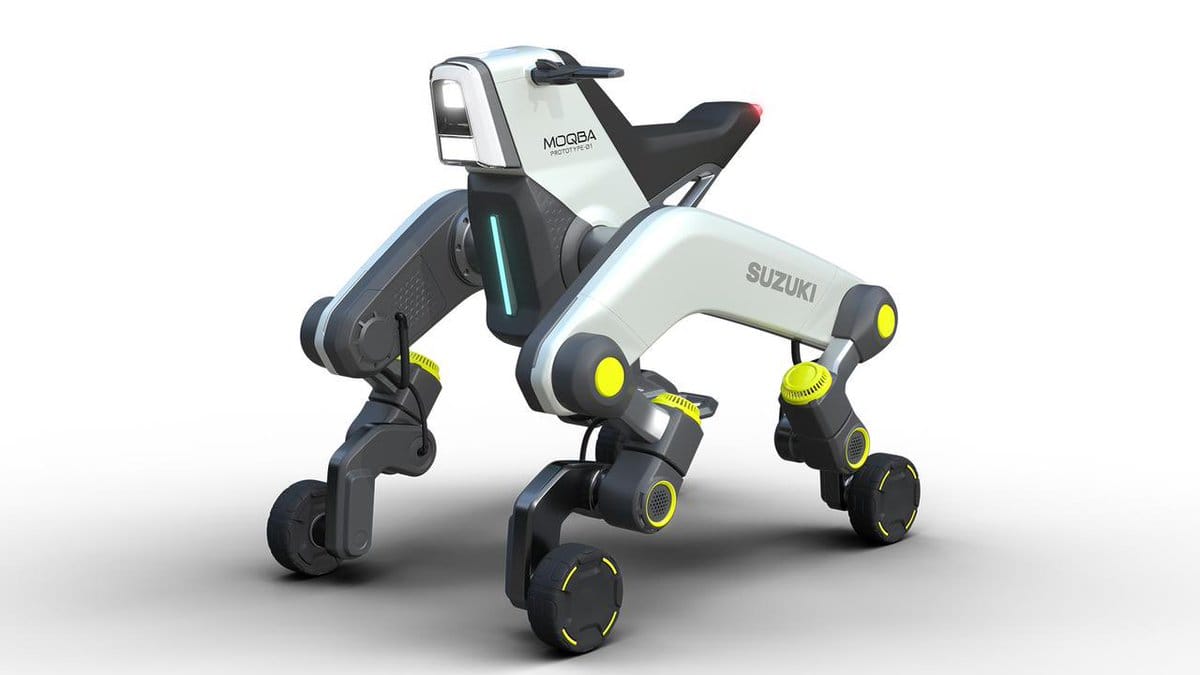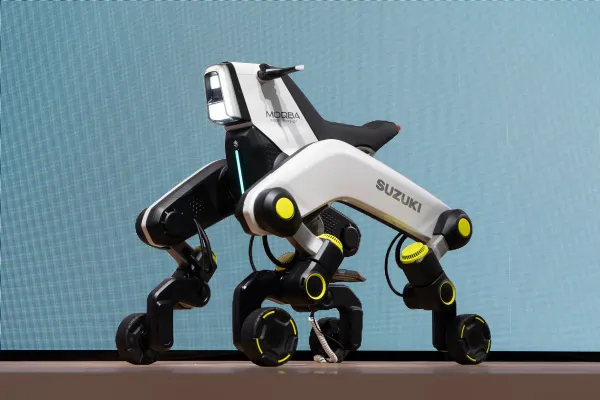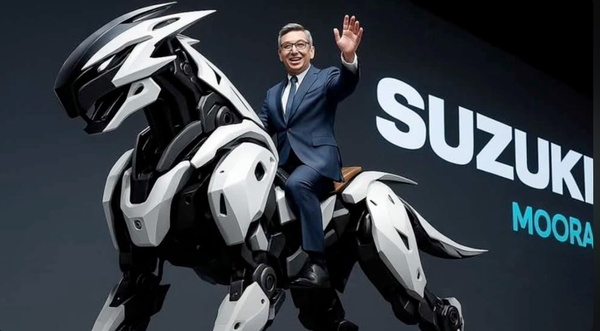In a groundbreaking leap for urban mobility, Suzuki unveiled the Moqba, a four-legged robotic vehicle designed to climb stairs and navigate challenging terrains with ease, on June 5, 2025. First introduced as a concept at the Japan Mobility Show in 2023, the Moqba—short for Modular Quad Based Architecture—has now entered the market at an accessible price of $3,000, promising to redefine accessibility and transportation in urban environments. With its innovative design, the Moqba can operate in multiple modes, making it a versatile solution for individuals with mobility challenges, urban commuters, and emergency responders. As cities grapple with aging populations, traffic congestion, and accessibility barriers, the Suzuki Moqba emerges as a revolutionary tool, blending cutting-edge robotics with practical applications. This article explores the Moqba’s design, technical specifications, societal impact, and its potential to shape the future of mobility.
Unveiling the Moqba: A Game-Changer in Mobility
Suzuki, a Japanese company traditionally known for its automobiles and motorcycles, has ventured into the realm of robotics with the Moqba, a four-legged vehicle that challenges conventional notions of transportation. The Moqba was first showcased as a prototype at the Japan Mobility Show in 2023, where it captured global attention for its animal-inspired design and ability to navigate stairs and uneven terrain. According to a report from singaporeuncensored.com, Suzuki officially launched the Moqba on June 5, 2025, bringing this innovative concept to market at a price of $3,000—a stark contrast to high-end quadruped robots like Boston Dynamics’ Spot, which retails for $75,000.
The Moqba’s design is both futuristic and functional, featuring a sleek white-and-black color scheme and a quadruped structure that mimics the movement of animals. Each of its four legs is equipped with small electric wheels mounted on a robotic framework with three degrees of freedom, as noted by interestingengineering.com. This hybrid design allows the Moqba to roll smoothly on flat surfaces while using its legs to climb stairs, traverse uneven terrain, and overcome obstacles like curbs and potholes. The robot’s chassis, described as a double-boomerang structure, provides stability and balance, ensuring it can carry a rider or payload without tipping.
One of the Moqba’s most revolutionary features is its stair-climbing capability, a significant advancement for urban accessibility. In cities where multi-level buildings, staircases, and uneven sidewalks are common, traditional wheeled vehicles like scooters or wheelchairs often fall short. The Moqba addresses this challenge head-on, enabling users to navigate environments that are typically inaccessible. For example, an elderly individual could use the Moqba to climb the stairs of a subway station, while a delivery worker could traverse a pedestrian overpass to complete a last-mile delivery. This stair-climbing ability, combined with its modular design, positions the Moqba as a transformative solution for urban mobility.
Modular Design: A Versatile Solution for Diverse Needs
The Moqba’s modular design is a cornerstone of its functionality, allowing it to adapt to a wide range of applications through three distinct modes: Chair Mode, Standing Mode, and Stretcher Mode. As detailed by singaporeuncensored.com, these modes enable the Moqba to serve multiple purposes, from assisting individuals with mobility challenges to supporting emergency response efforts.
Chair Mode: In this configuration, the Moqba transforms into a futuristic wheelchair, offering a comfortable seat for users to navigate urban environments. This mode is particularly beneficial for individuals with mobility impairments, such as the elderly or those with disabilities, providing them with a way to traverse stairs and uneven terrain without assistance. The Moqba’s four legs ensure stability, while its electric wheels allow for smooth movement on flat surfaces, making it an ideal solution for urban dwellers who face accessibility barriers.
Standing Mode: This mode allows users to move upright, offering a different perspective and experience. Standing Mode can be useful in crowded urban settings, where an elevated position helps users navigate through pedestrian traffic or monitor their surroundings. It also provides an alternative for users who prefer to stand while moving, catering to a broader range of preferences and physical needs.
Stretcher Mode: Designed for emergency scenarios, Stretcher Mode enables the Moqba to transport injured individuals over challenging terrain. In disaster-stricken areas, where infrastructure may be damaged, the Moqba can navigate rubble, stairwells, and uneven surfaces to evacuate the injured, offering a lifeline in situations where traditional stretchers or vehicles are impractical. This capability, highlighted by designboom.com, underscores the Moqba’s potential as a tool for emergency response, particularly in regions prone to natural disasters like earthquakes and tsunamis.
The Moqba’s modularity extends beyond its modes, with Suzuki planning to combine the base chassis with various attachments and body variations, as noted by designboom.com. These attachments could include a sit/stand motorcycle seat, a carry basket, or even a robotic arm, further expanding the Moqba’s utility. This adaptability makes the Moqba a Swiss Army knife of mobility solutions, capable of addressing diverse needs in urban environments, from personal transportation to logistics and disaster recovery.
Technical Specifications: Powering Urban Mobility
The Moqba’s technical specifications for urban use, balancing efficiency, versatility, and accessibility. The robot boasts a top speed of 20 mph (32 km/h) and a range of up to 50 miles (80 km) on a single charge, making it a viable alternative to traditional urban transport options like e-scooters or bikes. For example, a 50-mile range could cover a full day of errands or deliveries in a city like Tokyo, where the average commute is around 10-15 miles round trip. The Moqba’s electric powertrain aligns with global trends toward sustainable transport, reducing reliance on fossil fuel-powered vehicles and contributing to lower urban emissions.
The Moqba’s four-legged design is a key factor in its ability to climb stairs and navigate uneven terrain. Each leg features a small electric wheel mounted on a robotic framework with three degrees of freedom, allowing for a combination of walking and rolling movements. This hybrid design ensures the Moqba can move smoothly on flat surfaces while using its legs to overcome obstacles like stairs, curbs, and potholes. The robot’s “bendy limbs,” as described by designboom.com, can “squish like a sponge” to absorb shocks and adapt to changes in terrain, ensuring a stable and safe ride for users.
The Moqba’s technical capabilities are enhanced by recent advancements in artificial intelligence, which have revolutionized the robotics industry. According to the International Federation of Robotics (ifr.org), the integration of generative and analytical AI—dubbed the “ChatGPT moment” for physical AI—enables robots to simulate complex environments and adapt in real time. For the Moqba, this likely translates to improved navigation and stability, allowing it to handle urban obstacles with precision. Analytical AI optimizes task performance by processing data from sensors and cameras to make split-second decisions, ensuring the robot can navigate pedestrians, traffic, and obstacles in dynamic urban settings.
Societal Impact: Addressing Accessibility and Urban Challenges
The Moqba’s launch comes at a critical time, as cities worldwide grapple with accessibility barriers, aging populations, and urban congestion. In Japan, where the Moqba was developed, these challenges are particularly acute. The IFR projects that 38% of Japan’s population will be over 65 by 2035, creating a pressing need for assistive technologies that enhance mobility for the elderly. Many seniors face difficulties navigating stairs, uneven sidewalks, and crowded spaces, particularly in a country where accessibility infrastructure is not always comprehensive. The Moqba’s stair-climbing capability addresses this gap, enabling elderly users to move freely in environments not designed for accessibility. For instance, an elderly person could use the Moqba in Chair Mode to climb the stairs of a subway station or visit a multi-level shopping center, enhancing their independence and reducing the burden on caregivers.
The Moqba also tackles urban congestion, a growing issue as 54% of the global population now lives in cities, according to singaporeuncensored.com. Urban areas face significant challenges in managing traffic, emissions, and logistics, particularly in dense cities like Tokyo and Singapore. The Moqba’s compact design and electric powertrain make it an eco-friendly alternative to cars, capable of weaving through crowded streets without contributing to air pollution. Its 50-mile range and 20 mph speed are well-suited for short urban trips, such as commuting to work or running errands, reducing reliance on fossil fuel-powered vehicles.
In the realm of logistics, the Moqba’s stair-climbing ability and focus on smooth, flat-surface mobility make it an ideal solution for last-mile delivery, a growing trend highlighted by the IFR. In cities like Tokyo and Singapore, where traffic congestion and dense populations make traditional delivery methods inefficient, the Moqba can deliver packages in areas that are inaccessible to larger vehicles, such as stairwells or pedestrian zones. This capability aligns with the global e-commerce boom, offering a low-impact solution that reduces traffic congestion and emissions compared to delivery vans.
The Moqba’s Stretcher Mode further enhances its societal impact, particularly in disaster response. In regions prone to natural disasters like earthquakes and tsunamis—common in Japan—the Moqba can navigate damaged infrastructure to transport injured individuals, providing a lifeline in situations where traditional stretchers or vehicles are impractical. This application, noted by designboom.com, underscores the Moqba’s potential to save lives in emergency scenarios, making it a valuable tool for first responders and humanitarian organizations.
Competitive Landscape: Disrupting the Robotics Market
The Moqba’s $3,000 price point is a significant differentiator in a robotics market where high costs have historically limited consumer adoption. Boston Dynamics’ Spot, priced at $75,000, is a prime example of a robot designed for industrial use, with advanced features like 360-degree cameras, autonomous navigation, and payload capacities for heavy-duty tasks. However, its cost makes it inaccessible to most individuals and small businesses. Similarly, Unitree’s Go1, a quadruped robot popular in educational and research settings, retails at $5,000, still out of reach for many consumers.





